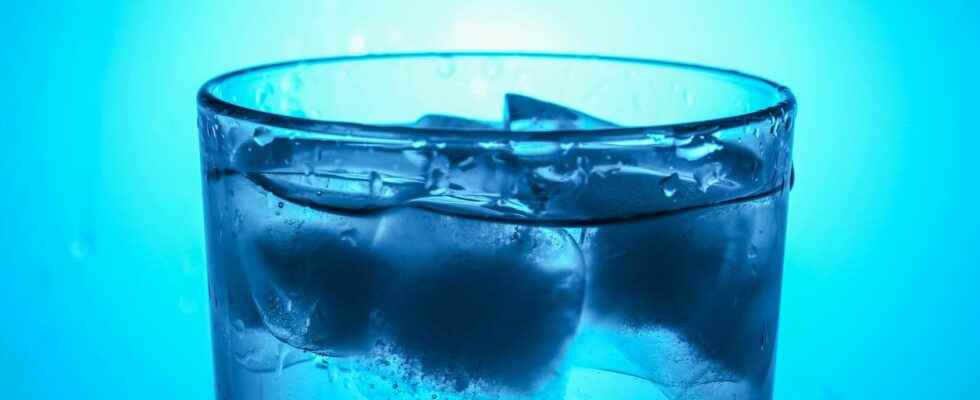Water, so commonplace and abundant on Earth, is nevertheless an almost unique substance: it has very astonishing chemical and physical properties and behaves in bizarre ways. Ice, liquid or water vapour: discover the mysteries of water.
You will also be interested
[EN VIDÉO] Can we recycle water endlessly? How can science help improve water management as part of the circular economy? This is the question posed by the actors behind the European nextGen project.
You think you know everything about molecule H2O? However, recent studies have just shown that water liquid can coexist in two different states! You’ve never seen a bar iron float on molten iron? The ice cubes float above the liquid water! In short, water is far from being a matter any.
Ice is less dense than liquid water
While almost all materials are denser in the state solid than in the liquid state, icebergs float on the ocean and the ice cubes float in a glass. Usually, when a substance freezes, its molecules come together. But the water has a anomaly : its maximum density is reached at 4°C and begins to decrease below. This means that, for the same volumethere are fewer molecules in an ice cube than in liquid water: it is therefore lighter.
Water is present in nature in its three states: liquid, solid, gaseous
It is easy to observe in nature ice, liquid water and water vapour. On the other hand, you will have little chance of finding gold vapor or dry ice — the solid shape of the carbon dioxide (CO2) — walking around outside! This strange property comes in particular from the temperature of merger particularly high water content: theoxygen alone evaporates for example at -183°C, but the hydrogen bonds between water molecules force to provide much moreenergy to pass to the vapor state.
Hot water freezes faster than cold water
Place an ice cube tray filled with hot water in the freezer and your ice cubes will be ready faster than with cold water. This curious phenomenon, called Mpemba effect would have several explanations. It could be due to evaporation which decreases the body of water and consumes heat, which promotes its cooling. Hot water would also be less sensitive to the effect of supercooling which allows a liquid to remain solid even when its temperature has fallen below its solidification threshold. Other hypotheses are based on heat transfers (the currents of convection would be more important in hot water) or the modification of the chemical bonds between the molecules of water (shrinking of the covalent bonds between the atoms oxygen and hydrogen).
There are two forms of liquid water
Recently, several studies have suggested that liquid water actually coexists in two forms : one of low density, in which the molecules form many hydrogen bonds with their neighbors, which keeps them at a distance from each other, and another of high density, where the molecules “stack” on top of each other. others and can therefore get closer. If it is relatively common to find several forms of solids for the same material, it is much rarer for a liquid. The only known case to date isheliumwhose liquid form helium II can crawl along surfaces!
Water is an excellent solvent
Just look at a piece of sugar melt in your coffee or powdered salt dissolve in your saucepan to realize: water is an excellent solvent. Conversely, it is impossible to dissolve salt in oil or oil : it will remain solid at the bottom of the container. This ability to dissolve is explained by the polar nature of water which tends to attract ionic molecules (with ions positively or negatively charged). When, for example, salt (NaCl) is put in water, the water molecules will dissociate the chloride ions and the sodium ions; an aqueous Na+ + Cl- solution is formed. Similarly, water easily dissolves other polar molecules such as sugars or ethanol.
Water can be both liquid and solid
Researchers have recently demonstrated the existence of superionic water », a semi-liquid and solid water which becomes conductive like a metal. Under very high conditions of pressure and temperature, the hydrogen bonds are destroyed, allowing the hydrogen ions to circulate freely in the lens network oxygen atoms, which remain organized as if they were “frozen”. Water can also occur in supercooled form, where it remains liquid down to temperatures of -48°C before suddenly freezing upon contact with another surface.
Water shrinks as it melts
The vast majority of substances occupy more space in the liquid state — when the molecules are disordered — than in the solid state — where the molecules have an organized structure. Water is a special case: it takes up about 10% more volume when it freezes. This oddity named ” dilatometric abnormality is explained by the particular structure of the water molecule, where the hydrogen bonds assemble in a hexagonal network, leaving a lot of space between the molecules.
Interested in what you just read?
